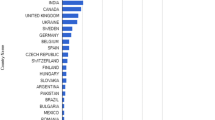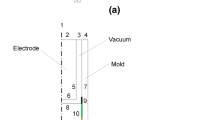Abstract
The spherical tokamak (ST) operates in a steady state with a high fusion gain. The 0-dimensional power balance model, including radiation losses to determine Q value as an inductive fusion gain, and the current balance model for determining \(Q_{\textrm{CD}}\) as a non-inductive fusion gain, is used to investigate the viability of D–\(^{3}\)He fuel for a steady-state operation. The spherical tokamak’s geometry, including the magnetic field \(B_{t}\) and \(\beta _{\textrm{th}}\) as a ratio of its kinetic pressure to the magnetic pressure, is used to analyse the impact of the confinement enhancement factor \(H_{y2}\) and the impurity density fraction \(f_{\textrm{I}}\) on \(Q_{\textrm{CD}}\). By comparing the obtained values with the device data, plasma characteristics, such as the safety factor \(q_{\textrm{I}}\) and Greenwald density limit \(N_{\textrm{G}}\) are examined to determine the optimum density limit and safety factor for an assurance about \(Q\approx Q_{\textrm{CD}}\) as the aim of steady-state operation. A comparison with ARIES-III performance is also made. The overall plant power balance equation is included. Furthermore, the desirable plant thermal efficiency value \(\eta _{\textrm{th}}\) and normalised beta value \(\beta _{N}\) for producing net electric power \(P_{\textrm{NET}}>\) 1 GW for the ST are achieved. Therefore, ST’s capability of having a lower aspect ratio A and higher elongation \(\kappa _{s}\) than ARIES-III in generating more significant fusion power with lower \(H_{y2}\) and higher energy confinement time \(\tau _{E}\) is approved.






Similar content being viewed by others
References
J J Chapman, in: Advanced fusion reactors for space propulsion and power systems, 38th International Conference on Plasma Science, 2011)
G L Kulcinski and J F Santarius, Nature 396, 724 (1998)
G De Temmerman, Joule 5, 1312 (2021)
O Mitarai, H Matsuura, T Omori, Sh Kajimoto, T Takahashi, Sh Koike and K Nakamura, Fusion Eng. Des. 136, 82 (2018)
Sh Chen and D Bernard, Chinese J. Phys. 66, 135 (2020)
L El-Guebaly and M Zucchetti, Fusion Eng. Des. 82, 351 (2007)
L J Wittenberg, J F Santarius and G L Kulcinski, Fusion Technol. 10, 167 (1986)
S V Ryzhkov, AIP Conf. Proc. 2318, 090008 (2021)
S Meschini, M Zucchetti and E Pagliuca, Fusion Sci. Technol. 77, 784 (2021)
M Zucchetti et al, Fusion Eng. Des. 88, 652 (2013)
S M Motevalli and F Fadaei, Pramana – J. Phys. 86, 837 (2016)
J F Santarius, G L Kulcinski, L El-Guebaly and H Y Khater, J. Fusion Energy 17, 33 (1998)
E Mazzucato, Fusion Sci. Technol. 77, 173 (2021)
Y K Peng, J D Galambos and P C Shipe, Fusion Technol. 21, 1729 (1992)
A Y Chirkov, J. Fusion Energy 32, 208 (2013)
S M Motevalli and F Fadaei, Z. Naturforsch. A: Phys. Sci. 70, 79 (2015)
A Sykes et al, Fusion Sci. Technol. 68, 237 (2015)
F Fadaei and S M Motevalli, Moscow Univ. Phys. Bull. 72, 535 (2017)
M Romanelli and F P Orsitto, Plasma Phys. Control. Fusion 63, 125004 (2021)
O Mitarai, R Yoshino and K Ushigusa, Nucl. Fusion 42, 1257 (2002)
S Shiraiwa et al, Phys. Rev. Lett. 92, 035001 (2004)
O Mitarai et al, J. Plasma Fusion Res. 80, 549 (2004)
F Sharifi, S M Motevalli and F Fadaei, Phys. Scr. 96, 095601 (2021)
Y Nagayama and Y Tomita, IEEJ Trans. Fundam. Mater. 125, 947 (2005)
O Mitarai, H Matsuura and Y Tomita, Fusion Eng. Des. 81, 2719 (2006)
K Tobita et al, Nucl. Fusion 49, 075029 (2009)
M Kikuchi and M Azumi, Rev. Mod. Phys. 84, 1807 (2012)
J Ongena, R Koch, R Wolf and H Zohm, Nat. Phys. 12, 398 (2016)
M Kikuchi, Nucl. Fusion 30, 265 (1990)
B Wan et al, Chin. Phys. Lett. 37, 045202 (2020)
HR Wilson et al, Nucl. Fusion 44, 917 (2004)
M C R Andrade and G O Ludwig, Plasma Phys. Control. Fusion 50, 065001 (2008)
R D Stambaugh, V S Chan, R L Miller and M J Schaffer, Fusion Technol. 33, 1 (1998)
Y Nagayama, in: Burning criteria for D-3He ST Reactor, 21st IEEE/NPS Symposium on Fusion Engineering (SOFE 05), 2005
CT Holcomb et al, Phys. Plasma 19, 032501 (2012)
J R Ferron et al, Nucl. Fusion 51, 063026 (2011)
T C Luce, Phys. Plasma 18, 030501 (2011)
D Maisonnier, I Cook, S Pierre and B Lorenzo, Fusion Eng. Des. 81, 1123 (2006)
F Najmabadi et al, Fusion Eng. Des. 80, 3 (2006)
A Sykes et al, IEEE Trans. Plasma Sci. 42, 482 (2014)
M Valovič et al, Nucl. Fusion 49, 075016 (2009)
SM Kaye et al, Nucl. Fusion 46, 848 (2006)
C Gormezano et al, Nucl. Fusion 47, S285 (2007)
T C Luce, Fusion Sci. Technol. 48, 1212 (2005)
A G Peeters, Plasma Phys. Control. Fusion 42, 12B, B231 (2000)
C C Petty et al, Nucl. Fusion 56, 016016 (2015)
R L Miller et al, General Atomics Report (1996)
M Ono and R Kaita, Phys. Plasma 22, 040501 (2015)
S C Jardin et al, Fusion Sci. Technol. 43, 161 (2003)
H Zohm, J. Fusion Energy 38, 3 (2019)
E Iter et al., Nucl. Fusion 39, 2175 (1999)
J R McNally, Nuclear Technol.-Fusion 2, 9 (1982)
R J Goldston and P H Rutherford, in: Introduction to plasma physics (CRC Press, 1995)
O Mitarai, Nuclear Reactors, Nuclear Fusion and Fusion Engineering, 405 (2009)
C G Bathke et al, The 14th IEEE/NPSS Symposium on Fusion Engineering 1, 219 (1991)
R J Buttery et al, Nucl. Fusion 61, 046028 (2021)
A E Costley, Nucl. Fusion 56, 066003 (2016)
S M Motevalli and M Safari, Fusion Eng. Des. 112, 53 (2016)
M Shubov, arXiv preprint, arXiv:2104.06251 (2021)
R J Akers et al, Nucl. Fusion 40, 1223 (2000)
B Shi, Plasma Sci. Technol. 7, 2767 (2005)
A E Costley, Philos. Trans. Roy. Soc. A 377, 20170439 (2019)
J E Menard, Philos. Trans. Roy. Soc. A 377, 20170440 (2019)
Acknowledgements
The authors take great pleasure in thanking the referee for his/her several suggestions and comments.
Author information
Authors and Affiliations
Corresponding author
Rights and permissions
Springer Nature or its licensor (e.g. a society or other partner) holds exclusive rights to this article under a publishing agreement with the author(s) or other rightsholder(s); author self-archiving of the accepted manuscript version of this article is solely governed by the terms of such publishing agreement and applicable law.
About this article
Cite this article
Sharifi, F., Motevalli, S.M. & Fadaei, F. The optimal values of Greenwald density limit and plasma safety factor in inductive and non-inductive operation modes. Pramana - J Phys 98, 63 (2024). https://doi.org/10.1007/s12043-024-02751-0
Received:
Revised:
Accepted:
Published:
DOI: https://doi.org/10.1007/s12043-024-02751-0




